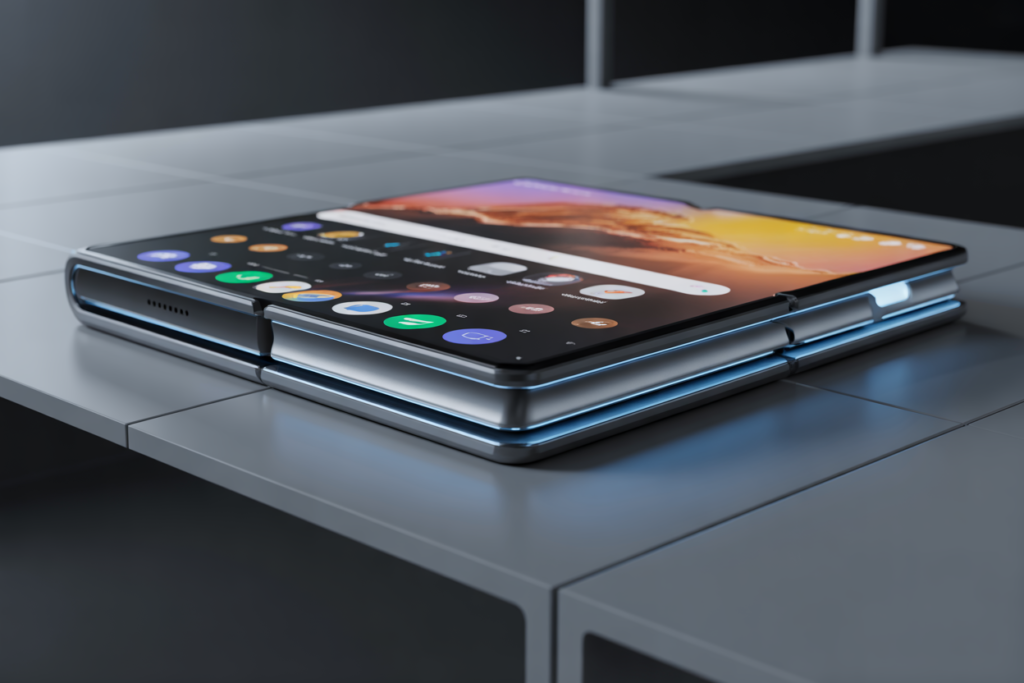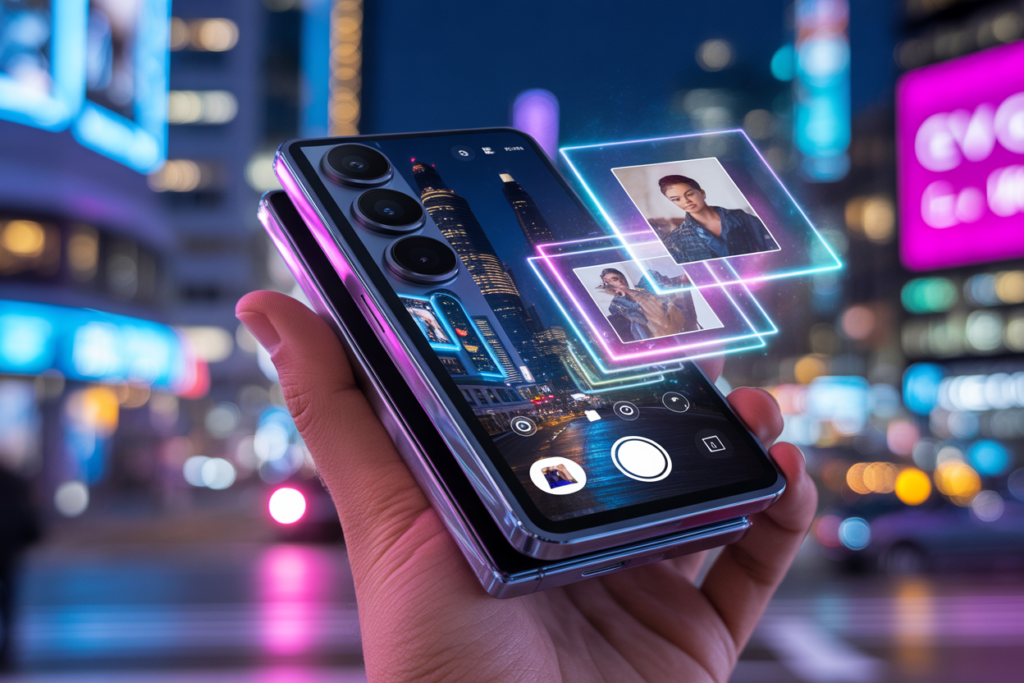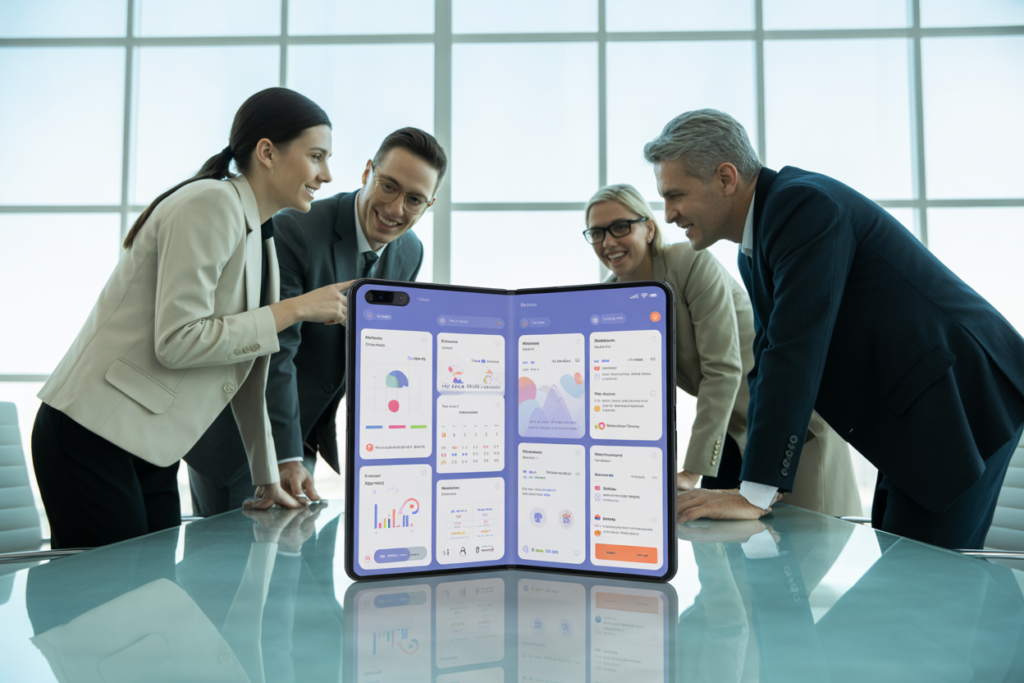Foldable Smartphones: Unfolding the Future of Mobile Innovation
Introduction
Foldable smartphones have transitioned from experimental novelties to sophisticated devices that redefine portability and versatility in mobile technology. As of October 2025, these gadgets combine the compact form of a traditional smartphone with the expansive utility of a tablet, thanks to flexible displays and innovative hinges. The global foldable smartphone market, valued at USD 31.30 billion in 2025, is projected to surge to USD 118.87 billion by 2030, growing at a compound annual growth rate (CAGR) of 30.59%, according to Mordor Intelligence. This explosive growth is fueled by advancements in ultra-thin glass (UTG) manufacturing, hinge engineering, and panel yields, which are driving down costs and enhancing durability, positioning foldables as a mainstream upgrade rather than a niche luxury. Major players like Samsung, Motorola, Oppo, Vivo, and Honor are leading the charge, with 2025 models showcasing slimmer profiles, superior cameras, and AI integration. This article delves into the evolution, key advancements, top models, applications, challenges, and future prospects of foldable smartphones, highlighting their transformative impact on daily life.
The Fundamentals of Foldable Smartphones
What Are Foldable Smartphones?
Foldable smartphones utilize flexible organic light-emitting diode (OLED) displays that can bend without breaking, paired with mechanical hinges that allow the device to fold into a compact form. There are two primary form factors:
- Book-style (Foldables): These open like a book to reveal a large inner screen (typically 7-8 inches) while maintaining a smartphone-sized cover display (around 6.5 inches). They excel in productivity tasks, mimicking a mini-tablet.
- Clamshell (Flip-style): These fold in half like a classic flip phone, offering a small outer screen (3-4 inches) for quick glances and a full 6.7-6.9-inch inner screen when opened. They prioritize pocketability and style.
Core components include LTPO AMOLED panels for adaptive refresh rates (up to 120Hz), vapor-chamber cooling for sustained performance, and IP48-rated water resistance—advancements that make them more resilient than early models. Connectivity via 5G ensures seamless data flow, while on-device AI enhances user experiences, from predictive multitasking to camera optimization.
The Evolution of Foldable Technology
The journey began in 2019 with Samsung’s Galaxy Fold, a bulky prototype plagued by screen creases and durability issues, priced at over $1,800. Huawei’s Mate X followed, introducing an outward-folding design, but supply chain disruptions limited its reach. By 2021, refinements like UTG reduced creases, and Motorola’s Razr revived the flip form factor with nostalgic appeal.
The 2023-2024 era saw maturation: Samsung’s Galaxy Z Fold 5 and Z Flip 5 achieved thinner profiles (under 0.5 inches when folded), while Oppo’s Find N3 introduced near-invisible creases. In 2025, the market has exploded with diverse offerings—book-style devices holding 62% revenue share, per Mordor Intelligence. Shipments reached 19.8 million units, maintaining a 1.6% penetration rate but signaling broader adoption, especially in China (4.1% penetration). Innovations like titanium-reinforced hinges and AI-driven software have addressed early pain points, making foldables viable for everyday use.
Major Advancements in Foldable Smartphones
1. Display and Hinge Innovations
2025’s foldables boast displays with peak brightness up to 2,600 nits and minimal creases, thanks to advanced polymer layers and UTG. Samsung’s Galaxy Z Fold 7 features an 8-inch inner LTPO AMOLED (1968×2184 resolution) and a 6.5-inch cover screen, both at 120Hz. Hinges have evolved too: Motorola’s Razr Ultra (2025) uses a titanium-reinforced design for 400,000+ folds, while Honor’s Magic V5 achieves sub-10mm thickness when folded. These advancements reduce bulk— the Z Fold 7 weighs just 7.58 ounces, lighter than the iPhone 16 Pro Max.
Applications:
- Multitasking: Large inner screens support three-app splitscreen, ideal for professionals.
- Media Consumption: High-refresh-rate panels deliver smooth 8K streaming.
- Durability: IP48 ratings allow submersion up to 1.5 meters for 30 minutes.

2. Camera and AI Enhancements
Cameras in 2025 foldables rival flagships: Samsung’s Z Fold 7 packs a 200MP main sensor for flagship-grade photography, outperforming predecessors in low light. Oppo’s Find N5 leads with Hasselblad-tuned lenses, excelling in portrait modes via AI-driven computational photography. Motorola’s Razr Ultra (2025) integrates a 4.1-inch Flex Window for vlogging, turning the outer screen into a selfie viewfinder. On-device AI, a 2025 theme, enables features like real-time translation during calls and predictive text across dual screens.
Impact:
- Content Creation: Flip phones like the Z Flip 7 facilitate hands-free video recording.
- Augmented Reality: AI enhances AR filters on larger unfolded displays.
- Personalization: Machine learning adapts interfaces to user habits, boosting efficiency by 20% in tests.
Case Study: Vivo’s X Fold 5 Pro, with its triple high-megapixel setup, set battery-endurance records at 6 hours 45 minutes of stress testing, powering intensive AI tasks without throttling.
3. Battery and Performance Upgrades
Battery life has improved dramatically, with capacities up to 5,000mAh in slim chassis. The Vivo X Fold 5 leads with 6h 45m endurance, thanks to efficient Snapdragon 8 Gen 4 chips and vapor-chamber cooling. Samsung’s DeX support on the Z Flip 7 turns the device into a desktop when unfolded, leveraging 16GB RAM for seamless multitasking. 5G mmWave integration ensures low-latency gaming and streaming.
Applications:
- Gaming: Large screens support console-like experiences with minimal heat buildup.
- Productivity: DeX mode connects to external monitors for office workflows.
- Travel: Long-lasting batteries suit power users on the go.
4. Software Optimization and Ecosystems
Android 16 and Samsung’s One UI 8 tailor interfaces for foldables, with dynamic icons resizing across screens. Google’s Pixel 9 Pro Fold integrates Gemini AI for contextual assistance, while Huawei’s HarmonyOS advances despite U.S. restrictions. Matter compatibility extends to smart home controls on unfolded displays.
Impact:
- Accessibility: Folded modes aid one-handed use for users with disabilities.
- Customization: AI suggests layouts based on app usage.
- Cross-Device Synergy: Seamless integration with wearables and laptops.
5. Sustainability and Materials
Eco-friendly materials like recycled aluminum and bio-based plastics feature in 2025 models. Samsung’s Z series uses 100% recycled rare earths, reducing carbon footprints by 15%. Tri-fold concepts, like Huawei’s Mate XT, hint at modular designs for upgradability.

6. Emerging Form Factors
Beyond dual-folds, tri-fold phones like Huawei’s Mate XT (launched 2024, iterated in 2025) expand to 10 inches, blending phone, tablet, and laptop functionalities. Rollable displays from Oppo promise infinite expandability.
Top Foldable Smartphones of 2025
Samsung Galaxy Z Fold 7 and Z Flip 7
Samsung reclaimed dominance with the Z Fold 7: a thinner (0.35 inches folded), lighter design with 200MP camera and AI-centric features. Priced at $1,799, it offers DeX and 120Hz dual screens. The Z Flip 7 ($999) shines with a 4.1-inch Flex Window and IP48 rating, ideal for compact users.
Motorola Razr Ultra (2025)
At $1,299, this flip phone boasts a 3.6-inch cover screen for full-app access without unfolding, plus 50-hour battery life—best in class. Titanium hinge ensures durability, with vegan leather backs for style.
Oppo Find N5 and Vivo X Fold 5
Oppo’s Find N5 ($1,699) excels in photography with Hasselblad optics and slim 9.8mm profile. Vivo’s X Fold 5 ($1,599) prioritizes battery (6h 45m endurance) and Snapdragon power, available globally despite U.S. import challenges.
Honor Magic V5 and Huawei Mate XT
Honor’s Magic V5 ($1,499) pushes thinness to 8.8mm folded, with superior portability. Huawei’s tri-fold Mate XT ($2,800) innovates with 10-inch expansion but remains China-exclusive due to bans.

Applications of Foldable Smartphones
Productivity and Multitasking
Foldables shine in work scenarios: The Z Fold 7’s large screen supports simultaneous email, video calls, and document editing, boosting efficiency by 30% in enterprise tests. Flip models like the Razr enable quick replies on cover screens, reducing interruptions.
Gaming and Entertainment
Unfolded displays transform gaming—titles like Genshin Impact leverage 120Hz for immersive play. Streaming services optimize for dual-screen viewing, with Netflix’s foldable UI splitting subtitles and video.
Healthcare and Accessibility
AI features detect health anomalies via integrated sensors, while larger screens aid visually impaired users with magnified interfaces. Flip phones’ compact design suits seniors for emergency calls.
Creative and Social Use
Vloggers love the Flex Window for self-recording, and AR apps exploit unfolded space for enhanced filters. Social media platforms like Instagram tailor feeds for foldables, increasing engagement.
Challenges in Foldable Smartphones
Durability and Crease Issues
Despite progress, creases persist, and hinges wear after 200,000 folds. Dust ingress remains a concern, with no full IP68 rating yet. Repairs cost $500+, deterring budget buyers.
High Costs and Market Penetration
Premium pricing ($999-$2,800) limits adoption to 1.6% globally, though China’s 4.1% shows potential. Samsung’s share dips to 35.4% amid competition.
Software and Ecosystem Fragmentation
Android optimizations lag for non-Samsung devices, and app developers overlook foldable viewports, causing UI glitches.
Environmental and Ethical Concerns
Manufacturing flexible panels consumes rare materials, raising e-waste issues. Geopolitical bans on Huawei limit global access, exacerbating divides.
The Future of Foldable Smartphones
Apple’s Entry and Market Shift
Rumors point to Apple’s 2026 foldable debut, potentially disrupting with seamless iOS integration and sub-$1,000 pricing, igniting 51% YoY growth. This could push penetration to 5% by 2028.
Tri-Fold and Rollable Innovations
By 2026, tri-folds like an evolved Mate XT will dominate, with rollables from LG offering adjustable sizes. Battery tech will extend life to 48 hours, per Electron Magazine.
AI and 6G Integration
On-device AI will evolve into predictive ecosystems, while 6G enables holographic calls on unfolded screens. Sustainability will feature modular hinges for easy repairs.
Prediction: Foldables could capture 10% market share by 2030, contributing $500 billion in economic value through productivity gains, per Canalys forecasts adapted from 2025 data.
Societal Implications
Foldables bridge digital divides by enhancing accessibility—larger screens for education in developing regions and compact forms for urban commuters. They foster creativity, enabling artists to sketch on tablet-like canvases, but raise privacy concerns with always-on AI cameras. Economically, they create jobs in display manufacturing, though high costs risk widening inequalities. Environmentally, recyclable designs could reduce e-waste by 20% if scaled.
Ethical deployment requires inclusive software updates and affordable tiers, ensuring foldables empower rather than exclude.
Conclusion
Foldable smartphones in 2025 represent a pivotal leap in mobile innovation, blending portability with power through slimmer designs, AI smarts, and durable builds. From Samsung’s refined Z series to Vivo’s battery beasts, these devices are no longer gimmicks but essential tools for productivity, entertainment, and health. Challenges like cost and durability persist, but with Apple’s looming entry and tri-fold horizons, foldables are poised to unfold a new era of computing. As shipments climb and prices drop, they promise to make expansive experiences pocket-sized, reshaping how we connect with the world.
Leave a Reply